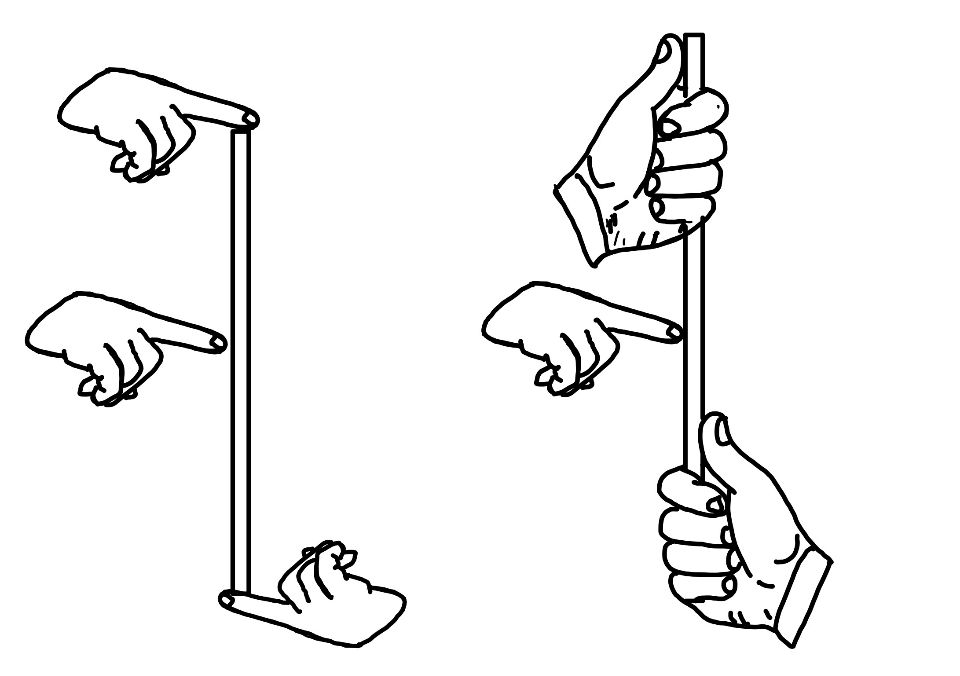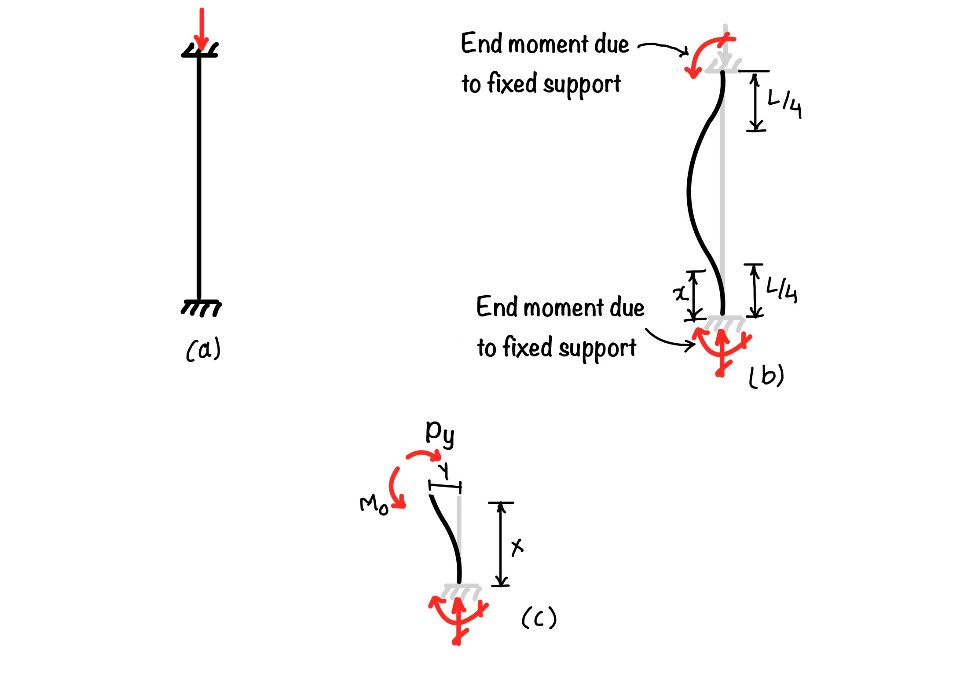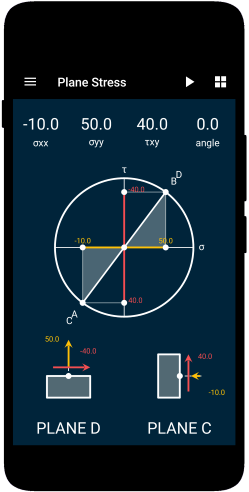The column behavior changes with the end condition. To demonstrate this, pick one piece of wire or the scale. Assume this as your column. In the first case, hold the column from the fingertip, as shown in the figure. Now ask your friend to push the column from the lateral direction.
Repeat the procedure after changing the end conditions. This time hold your column with both hands. You are making the fixed-fixed end condition. You will find you need more effort in the second case.

This change in the behavior of the column with the end condition also changes the critical load of the column. Therefore we will write the series of articles to address different end conditions like fixed-fixed, fixed-pin, fixed-free. And, in the present article, we will derive the critical load for the fixed-fixed end condition of the column.
Euler’s critical load for different conditions
Euler has derived the critical load for the pinned connection columns. In this article, we will derive the expression for the critical load of the column with other end conditions.
We will consider the following end conditions:
- Fixed-fixed: In this column, both ends are fixed. The end condition does not allow translation and rotation in the column.
- Fixed-free: One end fixed and one end free. In the free end, there will be no restriction on translation and rotation.
- Fixed-pinned: One end is fixed, and the other end is pinned. This means the rotation is allowed, but the translation is not allowed.
We will discuss the fixed-fixed condition column in this post. In the next two post we will discuss the other two end condition. Third post we will compare the outcomes and relate it with the Euler’s critical load.
What are the assumptions in Euler’s critical load?
The Euler’s critical load is derived for the pinned condition, as we have derived in the previous article. We are again writing the assumption while deriving the critical load for other end conditions.
Euler’s critical load has the following assumptions:
- The axis of the column is perfectly straight when there is no load in the column.
- The line of thrust co-insides with the unrestrained axis of the column.
- Flexural rigidity $EI$ is uniform.
- Material is isotropic and homogenous.
What will be differential equation for the column?
To obtain the differential equation for the fixed-fixed loading condition we need to draw the free body diagram of the column. The load in the column is $P$ which is cauding the buckling. The end moment at the both ends comes in the column refer part (b) of the figure.

The fixed end condition will cause moments at the ends as given in the part (c) of the figure. The deflection due to load which is equal to $y$ caused moment $Py$ in the clockwise direction and the end moment will be in the anticlockwise direction. Hence the elastic equation can now be written for this condition as:
$$ -EI\frac{d^2y}{dx^2}=-M_0 + Py \\ EI\frac{d^2y}{dx^2} + Py = M_0 $$
Solution for the above differential equation will be
$$ y=C_1\sin{\sqrt{\frac{P}{EI}}}x+C_2\cos{\sqrt{\frac{P}{EI}}}x +\frac{M_0}{P} $$
Hence, this equation represents the deflected shape of the fixed-fixed column.
What are the boundary conditions for fixed-fixed end conditions?
As you can see in the figure the above column has four boundary conditions. The two boundary condition at each end of the column. And the differential equation for the column shows three unknown. One boundary condition is extra redundancy in the present column.
$$ \text{ at }x=0 , y=0\ \text{ at } x=0 , \frac{dy}{dx}= 0 \\\text{ at } x=L, y=0\ \text{ at }x=L, \frac{dy}{dx}=0 $$
As we have already discusses the solution of the differential equation when both ends are fixed. Again repeating the same for convenience
$$ y=C_1\sin{\sqrt{\frac{P}{EI}}}x+C_2\cos{\sqrt{\frac{P}{EI}}}x +\frac{M_0}{P} $$
Now when we put $x=0$ in the above equation the first term $C_1\sin{\sqrt{\frac{P}{EI}}}x$ will be zero and the second term $C_2\cos{\sqrt{\frac{P}{EI}}}x$ will become $C_2$. Because the $\sin \theta =0 \text{ and } \cos \theta =1 \text { at } \theta = 0$ . Hence we can compute the value of $C_2$ as :
$$ \text{ at }x=0 , y=0 \Rightarrow C_2 = -\frac{M_0}{P} $$
As we have the other end condition in the slope that is $x=0, dy/dx =0$. Therefore, to apply the second end condition in the above equation, we need to calculate the derivative of the equation.
$$ \frac{dy}{dx}=C_1\sqrt{\frac{P}{EI}}\cos{\sqrt{\frac{P}{EI}}}x-C_2\sqrt{\frac{P}{EI}}\sin{\sqrt{\frac{P}{EI}}}x $$
Equation shown above gives the variation of slope. Not we can apply the slope boundary condition in the above equation
$$ \text{ at } x=0 , \frac{dy}{dx}= 0 \Rightarrow C_1 = 0 $$
Hence, after knowing the values of constants $C_1$ and $C_2$, we can put the values in the above equation.
$$ y=\frac{M_0}{P}\bigg( 1-\cos \sqrt{\frac{P}{EI}}x \bigg) $$
The above equation is the solution after putting the two boundary condition. In the next step we will apply the other two end conditions to get the critical load.
Euler’s critical load value
$$ \text{ at } x=L, y=0 \Rightarrow 1-\cos \sqrt{\frac{P}{EI}}L =0\\ $$
$$\cos{\sqrt{\frac{p}{EI}}} = 1$$
The $\cos\theta$ will be one for the $\theta = 0, 2\pi, 4\pi$ because for the odd values it becomes $-1$.
$$ \sqrt{\frac{p}{EI}} = 0,2\pi,4\pi$$
Hence to put the next end condition, we need to find the derivative of the deflection equation
$$ \frac{dy}{dx}=\frac{M_0}{P}\sqrt{\frac{P}{EI}}\sin \sqrt{\frac{P}{EI}}x $$
Putting the another end value in the above equation
$$ \text{ at }x=L, \frac{dy}{dx}=0 \Rightarrow \frac{M_0}{P}\sqrt{\frac{P}{EI}}\sin \sqrt{\frac{P}{EI}}L=0 $$
Hence we can say that, this condition $\sin \sqrt{\frac{P}{EI}}L=0 $ will be satisfied for $0,\pi,2\pi \dots$.
$$\sqrt{\frac{P}{EI}}L=0,\pi,2\pi \dots$$
Both the conditions will satisfy when the
$$\sqrt{\frac{P}{EI}}L=0,2\pi,4\pi \dots$$
Therefore, now choose the least significant value, we will choose $2\pi$. Hence the critical load for this column will be
$$P_{cr} = \frac{4\pi^2EI}{L^2}$$
Conclusion
You have derived the critical load for the column with fixed-fixed end conditions in this post. This end condition changes the behavior of the column hence the critical load. For other end conditions combinations like fixed-free and fixed-pin, we will derive the critical load in another post.
You have learned following key points in this article:
- Critical load: The critical load for the column having said end condition is $P_{cr} = \frac{4\pi^2EI}{L^2}$.
- Boundary values: The boundary condition for the fixed-fixed end condition are displacement, and the slope at both points is zero.
Solid Mechanics
In this app, you would be able to explore the world of Solid Mechanics. The app covers many important topics in the field of solid mechanics.
- Interactive Mohr’s Circle of Stress and Strain.
- Calculators for Stress and Strain Analysis.
- Graphical representations of failure criteria.
- A detailed description of key concepts of Solid Mechanics with diagrams.

This article was crafted by a group of experts at eigenplus to ensure it adheres to our strict quality standards. The individuals who contributed to this article are:
Author


